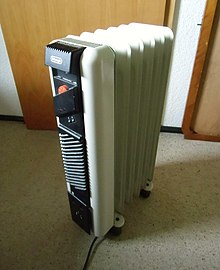Oil radiator
An oil radiator is an electric heater for closed rooms. It can be used in addition to a permanently installed heating system ( central heating , stove heating , fireplace ) or as the sole heating system. Typical areas of application are rooms that are used irregularly or infrequently and where it is not worth installing a fixed heating system.
Basics
Oil radiators are electrical heating devices. They are typically designed as ribbed radiators that are equipped with wheels to ensure high mobility. They also have a power connection and various control elements (at least one switch, temperature selector and timer depending on the comfort level) for various functions and setting options. Due to the ribs on the heating body, the radiating surface is larger than with a flat radiator construction, which makes heating more effective.
functionality
Inside an oil radiator there is an oil ( thermal oil ) as a heat transfer medium, which is heated by an electric current and radiates heat to the environment via the ribs of the heating element.
When the power supply is switched on, heating elements inside the oil radiator are heated, which give off this heat to the oil bath. The entire radiator is heated by convection and the heat is released into the environment via the metal surface. Compared to fan heaters, oil radiators tend to be slow to generate heat, but thanks to the thermal oil's ability to store heat, they allow continuous heat dissipation to the environment.
Oil is used as a transmission medium instead of water because it expands less when it is heated. In addition, oil is a good insulator, which allows the heating resistors to be immersed directly in the oil bath, which significantly improves the effectiveness of the heat exchange process. In contrast to water, oil is less corrosive or non- corrosive at all , which improves the service life of the devices. Another reason for the use of oil is the lower specific weight compared to water.
Comfortable devices have additional functions and setting options:
- Thermostat function
- Frost guard function
- Step or stepless circuit breaker
- Timer / program function
In contrast to fan heaters , typical oil radiators work quietly because they do not have a fan - only the warming oil usually makes low noises. A special form are combination devices consisting of an oil radiator and a fan heater, which allow faster heat dissipation at the beginning of the heating process, which is achieved using a switchable fan.
operation area
Oil radiators are used in rooms that are not (or cannot) be heated regularly or in rooms where there is no permanently installed heating facility. Since the devices are typically mounted on castors and mostly designed to save weight, they are mobile, transportable and versatile. Possible places of use are: garages, cellars, gazebos, attics, winter gardens, shell structures, damaged objects. They can be used in the event of defects in an existing heating system or in the event of temporary cold spells when it is not yet worthwhile to put a permanently installed heating system back into operation.
The acquisition costs of oil radiators are usually low, but their power consumption during operation is high to very high (typical connected load 1000 W to 2500 W).
Individual evidence
- ↑ a b c d e The oil radiator as additional electrical heating. In: Alexander Rosenkranz, VC / O GmbH - Viessmann Group, 10117 Berlin, heizung.de. May 22, 2019. Retrieved November 19, 2019 .
- ↑ Oil radiator. In: Thermondo GmbH, D-10115 Berlin, thermondo.de. 2019, accessed November 19, 2019 .
- ↑ a b What is an oil radiator and what is it good for? In: Enrico Lauterschlag, 21423 Winsen (Luhe), heizkoerper-wissen.de. 2019, accessed November 19, 2019 .
